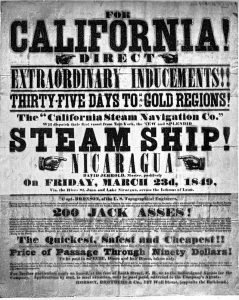
Virtually all Americans know of the connection between slavery and the Civil War, but many have never even heard of one of the other major connections: the sinking of the S.S. Central America on September 12, 1857, with the upcoming 166th anniversary on the horizon. It was by no means an ordinary shipwreck.
How could have this significant event been forgotten? Because the American Civil War was – and remains – an extremely complicated conundrum mixture of social, economic, political, and moral causes. It is precisely that complexity that has clouded issues. We like things simple. We want everyone to understand the huge parts of our history; we want small children to understand. So, we grossly oversimplify.
The U.S.A. in 1860 was a very separated Divided States of America. It was divided into four major sections: the Northeast, the Midwest, the South, and the West. Each section was represented by a separate party. Each wanted its own way. The Northeast had the largest population and so it won.
That became a major cause of upcoming conflict, because the Republicans and Lincoln had platforms and policies that not only favored the Northeast but also hurt the other sections economically, especially the South. And the economics were a huge key.
The Ship of Gold

America’s history changed dramatically in 1848 when gold was discovered in Sutter’s Mill, Coloma, California, (45 miles east of Sacramento). The news quickly spread and the “49-ers” numbered 4,000 the following year. Soon, it reached tens of thousands. One of the best lines to come out the California Gold Rush of 1849 was “Never have so many worked so hard to not work!”
When the Mexican-American war ended in 1848, California became an American possession, with gold being the most obvious reason why. To that end, the U.S. government subsidized private companies to build and operate two fleets of sidewheel paddle steamships. One fleet operated from California to Panama in the Pacific. The other fleet from Panama to New York in the Atlantic. The idea was to efficiently connect the old U.S. East Coast with the new U.S. West Coast for news, mail, and passengers. The overwhelmingly obvious reason was to simply to transport that huge volume of gold to the U.S. Treasury which was constantly pouring out of California.
Here is where the sidewheel paddler SS Central America comes in. The great number of details omitted here can be found in Chapter 21 of my book Shipwrecks of the Outer Banks: Dramatic Rescues and Fantastic Wrecks in the Graveyard of the Atlantic, Globe Pequot Press.
Central America’s Final Voyage
William Herndon, United States Navy Captain, departs the port of Aspinwale, Panama on Thursday, September 3, 1857. The S.S. Central America was carrying the now-usual 467 passengers, 102 crew members, and over 30,000 pounds of gold, $1.6 million value in gold then ($140,000,000 today). Several days later, she docks in Havana, Cuba for a routine stop. There, more passengers come aboard, and among them are Mr. H.H. Childs. Central America departs on Tuesday, September 8, now bound directly for New York.
An eyewitness account from passenger Mr. H. H. Childs, “The weather was delightful and the sea calm” that day. However, on Friday, September 11, “On the following morning… storm raged fearfully.” Actually, Central America had found itself in the fury of a hurricane for which the Graveyard of the Atlantic is famous. Central America began taking on water. The violent waves rocked the ship unmercifully, making it virtually impossible to feed coal to the boilers, thus she was losing power. A bucket brigade of men was quickly formed, and they bailed.
By just after noon on Saturday, the fate of the Central America appeared to be hopeless. A few minutes past 8:00 p.m. a tremendous rogue wave completely engulfed the Central America sinking it immediately.
Childs continues, “I think some four hundred or four hundred and fifty souls were launched upon the ocean at the mercy of the waves.” He chronicles the fact that for several hours the group floated helplessly and silently. Then, “I saw my comrades sink fast, and at 1 o’clock that night I was nearly alone upon the ocean, some two hundred miles from land.” He was one of only 100 passengers who made their way over in lifeboats to two vessels appearing nearby the next morning. Captain William Herndon stoically went down with his ship.
A total of 425 (some accounts have 426) passengers and crew lost their lives in the greatest maritime disaster in history to date. Also lost disastrously was over 140 million dollars of period value of the 30,000 pounds of gold onboard.
The overall American economy was on very shaky ground at this point. Some excerpts:
Significance and Consequences
“When news came through the telegraph wires that the ship had sunk off the coast of North Carolina, the country went into a panic. It was a time when the country relied on gold to back its banking transactions. Banks closed, businesses went bankrupt and the financial Panic of 1857 deepened – all because the much-awaited Ship of Gold had disappeared with tons of needed gold on board.” This was reported by Mike Fuljenz in an article for the Association of Mature American Citizens, on April 5, 2018.
The Monaco Rare Coins website tells us, “The ‘Ship of Gold,’ sank in deep water off the coast of the Carolinas. The loss has been described as the greatest economic catastrophe in all of U.S. maritime history, triggering the Panic of 1857, a severe recession, and a deep depression.” This not only hurt the nation, but it also further divided it, since the North was hurt the most.
Further effects include “It was one of the worst maritime disasters of the 19th century. The ripple effect of the Central America sinking went far beyond the loss of the ship and its crew, however. The 30,000 pounds of gold aboard the Central America was equal to about 20% of the gold held in New York banks at the time. This was an era when the currency system was not regulated by the federal government, and thus was subject to highly dangerous fluctuations, speculation, runs, and other financial hazards,” author Sean Munger elaborates in his September 12, 2013 article “The S.S. Central America: The Ship That Helped Wreck a Nation.”
Problems multiply: “In September 1857, Ohio Life Insurance and Trust Company – a major banking institution based in New York – collapsed, with rumors of embezzlement rife.”
“The ensuing panic led to many customers trying to withdraw their money from other banks. For this reason, a particularly large cargo of an estimated another 30,000 pounds of gold was dispatched from the San Francisco Mint to shore up eastern banks,” so learned from the UK Telegraph article of January 29, 2015, by Andrew Marzal.
Adding to this economic instability and the social and cultural diversity and the friction of “sectionalism” was political instability. The presidential election following the Panic of 1857 was only three years later. Many divisive and negative events would lead up to this – the Missouri Compromise reversed later by the Kansas-Nebraska Act, tariff issues that benefitted the North and hurt the South, the polarizing U.S. Supreme Court “Dred Scott Decision,” and finally, the terrorist act of John Brown’s Raid in Virginia only a year before the election.
Many of those divisions, scars, and sectional rivalries remain in our country today over a century-and-a-half later. The tragic shipwreck of S.S. Central America unwittingly was a prime catalyst to those prime developments. It was a complicated major cause of an American tragedy that has been oversimplified – and easily forgotten.
This article contains new material as well as excerpts from “Shipwrecks of the Outer Banks: Dramatic Rescues and Fantastic Wrecks in the Graveyard of the Atlantic,” Globe Pequot Press (imprint of Rowman & Littlefield), by James D. Charlet, © 2020. James D. Charlet also performs a variety of “live-theater” programs for “Keeper James Presentations” based on extracts from chapters in his book. He can be reached at keeperJamesLSS@gmail.com.
Keeper James will also be hosting presentations on the wreck of the Ephraim Williams at the following events:
– Day at the Docks, Hatteras Village, Saturday, Sept 16, Main Stage, 11:30
– Cape Hatteras Lighthouse, Pavilion, Monday, Sept 18, 1:30
September 10, 2023 at 08:45PM
https://news.google.com/rss/articles/CBMingFodHRwczovL2lzbGFuZGZyZWVwcmVzcy5vcmcvaGF0dGVyYXMtaXNsYW5kLWZlYXR1cmVzL2lzbGFuZC1oaXN0b3J5LTE2NnRoLWFubml2ZXJzYXJ5LW9mLWEtbGl0dGxlLWtub3duLWJ1dC1tYWpvci1jYXVzZS1vZi10aGUtYW1lcmljYW4tY2l2aWwtd2FyLWEtc2hpcHdyZWNrL9IBAA?oc=5
Island History: 166th Anniversary of a little-known but major cause of the American Civil War: A Shipwreck - Island Free Press
https://news.google.com/search?q=little&hl=en-US&gl=US&ceid=US:en

No comments:
Post a Comment